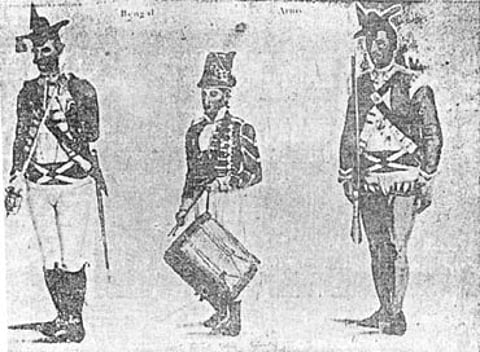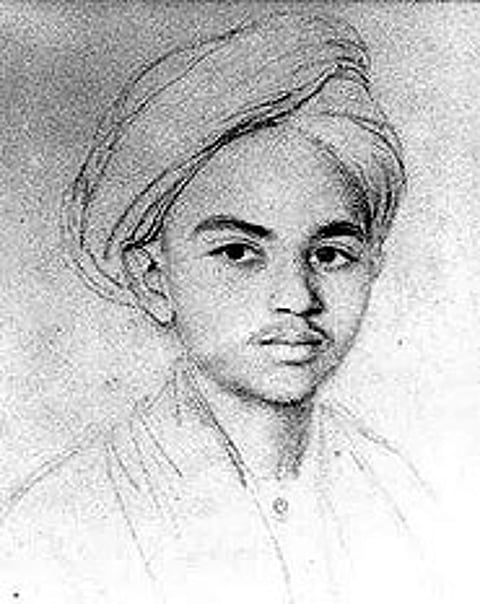July, 1806 Vellore
The mutiny at Vellore Fort was the first against the Brits, but few recall it as such
Though discontent had been brewing among the Indian soldiers drawn fromvarious parts of the Deccan over poor treatment, loss of erstwhile status, andpoor pay, the immediate provocation for the unbridled outburst of aggression wasapparently the introduction of a controversial new turban, viewed by Indians asa firangi topi (hat), and the implementation of new regulations over thesporting of caste marks on foreheads, earrings and facial hair. This Code ofMilitary Regulations was given approbation on 13 March 1806 by Sir John Cradock,commander-in-chief of the Madras Army.
Lending political and historical weight to the cause of the rebels was thepresence of a huge contingent of Tipu Sultan’s family -- twelve sons and eightdaughters -- stationed in various mahals within the fort precincts since thefall of Srirangapatnam in 1799. The entire retinue, with servants and followersnumbering a few hundreds, lived in privacy and palatial comfort though strippedof their former princely glory. According to S.S. Furnell, the first historianto document the mutiny in his The Mutiny of Vellore, whose fragmentssurvive in the Madras Archives, more than 3,000 Mysoreans (mostly ‘Mohammedans’)had settled in Vellore and its vicinity after it became the abode of theprinces. After the English drubbed the French in the Carnatic wars, several ‘nativesoldiers’ were employed by the East India Company. Of these, a sizeable numberwere Tipu’s former soldiers, especially of officer rank. They had reason tomake common cause with their former masters -- Tipu’s legatees stationed inthe Vellore fort.

the controversial turban (sported by the man in the middle)
According to Maya Gupta’s research based largely on sources in the IndiaOffice library, London, on 6 May 1806, 29 sepoys of the second battalion of the4th Regiment who were ordered to wear the new turban refused. Continuing theirdefiance the following day, placing handkerchiefs on their bare heads, theyabused the English officers as ‘dogs’. The insubordinate sepoys wereconfined to Madras and court-martialed. While punishment was spared to sepoyswho regretted and relented, two defiant havildars -- one Muslim, one Hindu --were subjected to 900 lashes. In June, a similar anti-turban agitation rockedWallajhabad in the vicinity of Vellore.
On 17 June, Mustafa Beg, a sepoy of the 1st Regiment, leaked news of thebrewing conspiracy to his commanding officer Lt. Col. Forbes. The officer soughtthe opinion of the native officers who dismissed the plot and declared Beg to beinsane. Beg was transferred and placed in confinement only to be later rewardedwith 7,000 rupees and a subedar’s pension. Volumes of Secret Sundries(British military records), believed, in hindsight, that the mutineers,especially those of officer rank, seeking to reinstate the rule of Mysore, werein touch with the Poligars (feudal chieftains in the Deccan), the Holkars, theMarathas, the deposed rulers of Hyderabad and even the French in Pondicherry.They had set July 14 as the common date for mutiny, but Beg’s treachery hadhastened them.

British military records say that 787 soldiers escaped and 446 wererecaptured largely from areas such as Salem, Madurai and Tirunelveli. Accordingto Secret Despatches, Vol 33, "Six convicted mutineers were blown awayfrom guns [canons], five were shot with musketry, eight were hung." Theseexecutions took place in the western part of the fort. In the Manual of theNorth Arcot District (1898) magistrate Arthur C. Fox notes with unrestrainedglee that the execution by blowing away from the guns "produced theprofoundest impression. A spectator describes how numbers of kites accompaniedthe party to the place of execution, flapping their wings and screeching as ifin anticipation of the bloody feast, till the fatal flash which scattered theirfragments of bodies in air, when, pouncing on their prey, they caught in theirtalons many pieces of quivering flesh before they could reach the ground. Atsight of this the native troops employed on duty, together with the crowdassembled to witness the execution, set up a yell of horror." Such horrorsperhaps left a devastating impression on the south for it to bypass 1857.
On why this incident has remained on the fringes of the national imagination,A.R. Venkatachalapthy, associate professor with the Madras Institute ofDevelopment Studies, says: "Tamil Nadu has always been on the margins ofnationalist historiography, dominated as it has been by the north and Bengal.The ‘anti-nationalist’ trajectory that TN took even by the late 1920s underPeriyar and subsequent phenomena like the anti-Hindi agitation and the rise ofthe DMK, seemed to justify such marginalisation. The silence over Vellore mustbe understood in this background." He reckons that Vellore was a mutiny in thestrict sense of the word. "It started in the barracks and lay confined to it,whereas 1857 began as a mutiny and spread over large parts of north India as acivil rebellion."
Today, Tipu Mahal in Vellore fort, the seat of conspiracy, is underunsupervised renovation. It is now part of a Police Training College wheresub-inspectors of the TN Police used to train -- bathing and defecating whereroyalty once lived. The sub-inspectors made way for the mahal to be rendered ahigh-security prison for LTTE cadre. Another day, another rebellion. On 15August 1995, 43 LTTE cadres lodged in Tipu Mahal escaped after digging a153-foot tunnel through the moat. Shamefaced, the TN police has since barredaccess to the mahal. As a muted commemoration of the historic rising begins, theTamil public may well be denied a peek into the place where history was made.
A slightly shorter, edited version of this appears in print.
Tags